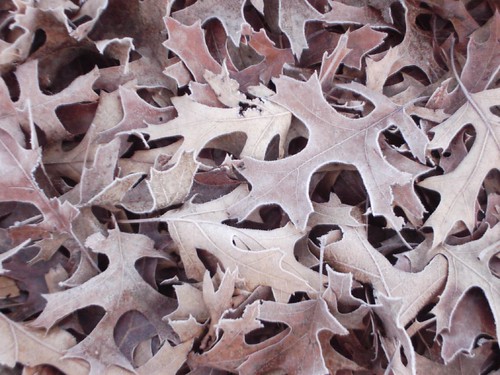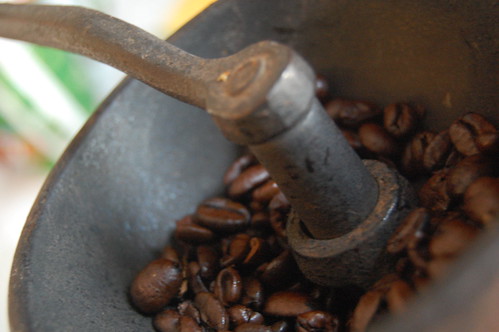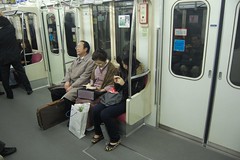We lowly 一年生 have been delegated the task of discerning the ways in which katakana is used in the Modern Japanese language. Here is but one attempt to elucidate how one of the three writing systems of Japanese may be used.
The following three categories describe straightforward uses of katakana:
1) Loan words from other languages (e.g. クラス、ハム、チリサース)
2) Names from other languages (this is quite similar to 1; e.g. スミス)
3) Onomatopoeia (e.g. for frog sounds ケロケロ)
Another category which my cohort has come up with is "emphasis" which uses "Japanese" words (i.e. words which are not borrowed from other languages and which would likely not be written in katakana if you looked them up in the dictionary) What exactly does this mean?
I will give a few examples which will fall into this category. First take a look at the examples, then I will write a bit about what I think is happening. The first comes from a book title, "日本タテヨコ" which literally means "Japan Length and Width". It is a bilingual guide to Japan, the English name is Japan As It Is.
I will throw in a couple photos from my day in Japan. Here is another example, take a look. What word dominates (at least in katakana)?
カラオケ: Karaoke!
And I will post one more, just for good measure (which I consider more or less the same type as above)
This was taken from the Narita Express from Narita to Tokyo station. A fair number of the signs are in katakana, and at least for me they are much more legible than the kanji--at least when one is on a moving train. I think this speaks to some of the usage of katakana, especially in advertising, newspaper headlines et cetera. The simplicity and style of the strokes of katakana have significant impact at a glance (in comparison to hiragana or kanji). I am not sure how this reads for fluent/native Japanese speakers (readers). Is this more subtle when all three writing systems are legible at a glance? The Ro-maji in the above photo also stick out (at least for me).
So what exactly does emphasis mean? It seems to use the innate qualities of katakana to point to words in unique ways. Katakana is described by many as blocky, not round, simple, easy to discern at a glance, et cetera. It is also considered "masculine" as opposed to the "feminine" hiragana (scroll down to "History" section). Some of these qualities may be taught (isn't it hard to make judgement as to the qualities of an alphabet without cultural input?). Some of these qualities may be present for some people and not others.
Does it strike anyone else that, having three writing systems, Japanese seems not only to have basic rules for which words fall into which category, but also employs the use of the systems in more ephemeral ways (i.e. what I am calling "emphasis")? A non-katakana example could be the choice to use relatively advanced kanji to appear more scholarly/educated. That is why I argue that despite there being general rules for how Japanese writing systems are utilized, that not only will people vary in their use, but also that the connotative meanings may also vary (not dramatically, but slightly).
But do not despair, fellow students of Japanese! This is merely a wonderful example of the magic of language. Humans have developed languages which despite using arbitrary sets of symbols and sounds to represent all sorts of meanings, allow two or more different minds to communicate ideas. This communication is flawed, but that doesn't mean that language itself fails, even two people who are both native speakers (with similar backgrounds) of a language are likely to have slightly different ideas for specific terms. Just think of what happens if the two speakers don't share culture. Welcome to Semantics. The magic, in my opinion, is that we understand each other rather well most of the time. The fun is learning a language where there are three writing systems. But now ends my linguistics rant.
In looking through my photos and my husband's photos from Japan, I actually found it difficult to pick out katakana that I felt were being used for emphasis. Or at least difficult to find "impressive" examples. Most of the katakana was loan words. I am also sure that I missed some because of the basic level at which I can read Japanese. I thought I would find more examples where Japanese food names were written in katakana (as menus are "supposed" to be one use of katakana for impact), but the opposite was true. I will show you an example of where I did not find katakana (apologies if it is not super clear, but if you can read Japanese you should be able to see what I am talking about):
Is the menu of fish available written in hiragana to seem more Japanese? Is this in opposition to the many examples of loan words and katakana used in pre-packaged foods? Maybe this "negative" example can contribute as well. What other "negative" uses of katakana can you think of?
I think this somewhat elusive categorization of katakana speaks to potential differences in the way that its use is taught, and the way that people learn katakana use by encountering it "out in the wild". I am not at all surprised to hear that different Japanese language textbooks describe it differently. I think the question of katakana analysis will never quite be reducible to one explanation, and that the subtlety of use is part of the fun! Hopefully that also means that my fellow Japanese students (now and future) will continue to come up with interesting ideas on the matter.
apologies if the font/layout is a bit wonky, I tried to smooth things out but it still looks funny to me in a couple spots.






